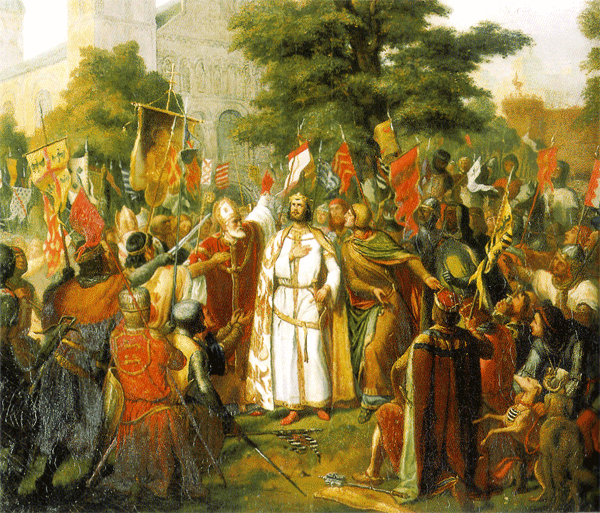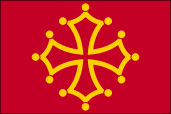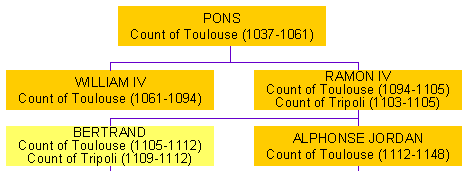The Counts of Toulouse: ( Coms
de Toloza): Coms
de Toloza):
 Raymond IV,
Raymond IV,  Ramon IV,
Ramon IV,  Raimon IV, c.1038-1105, Count of Toulouse (1093-1105)
Raimon IV, c.1038-1105, Count of Toulouse (1093-1105)
, ,
Raymond IV is sometimes known as Raymond of Saint-Gilles,
after the family seat to the south of Nīmes. He was Count
of Toulouse, Marquis (or Margrave) of Provence, and one of
the leaders of the First Crusade. He succeeded his brother
William IV as Count of Toulouse in 1088.
 According
to an Armenian source, he had lost an eye on a pilgrimage
to Jerusalem before the First Crusade. He fought against the
Moors in Spain before 1096, and he was the first to join the
crusade after Pope Urban II's sermon at the Council of Clermont. According
to an Armenian source, he had lost an eye on a pilgrimage
to Jerusalem before the First Crusade. He fought against the
Moors in Spain before 1096, and he was the first to join the
crusade after Pope Urban II's sermon at the Council of Clermont.
|
Raymond IV was the senior nobleman among the five leaders
of the First Crusade. The oldest and the richest of
the crusaders, Raymond IV left Toulouse at the end of
October 1096, with a large company that included his
wife Elvira, his son Bertrand, and Adhemar, bishop of
Puy, the papal legate. He marched to Dyrrhachium, and
then east to Constantinople along the same route used
by Bohemund of Taranto. At the end of April, 1097, he
was the only crusade leader not to swear an oath of
fealty to Byzantine Emperor Alexius I - instead he swore
an oath of friendship, and offered his support against
Bohemund, both Raymond and Alexius' mutual enemy. (Consequently,
he was the only western Crusader not to break his solemn
oath).
He was present at the siege of Nicaea and the Battle
of Dorylaeum in 1097, but his first major role came
in October of 1097 at the siege of Antioch. The crusaders
heard a rumour that Antioch had been deserted by the
Seljuk Turks, so Raymond sent his army ahead to occupy
it, offending Bohemund of Taranto who wanted the city
for himself. The city was, however, still occupied,
and was taken by the crusaders only after a difficult
siege in June of 1098. Raymond took the palatium
cassiani (the palace of the emir, Yaghi-Siyan) and
the tower over the Bridge Gate. He was ill during the
second siege of Antioch by Kerbogha, and so missed an
outbreak of bogus miracles, which culminated in the
discovery of the Holy Lance by a monk named Peter Bartholomew.
|
|
|
Adhemar
of Le Puy (in red) acclaims Raymond IV (in white
and gold) as leader of the First Crusade, according
to a nineteenth century French artist.
|
|
|
|
  The
"miracle" raised the morale of the crusaders, and to their
own surprise they were able to rout Kerbogha outside Antioch.
The Lance itself became a valuable relic among Raymond's followers,
despite Adhemar of Le Puy's skepticism and Bohemund's outright
mockery. The
"miracle" raised the morale of the crusaders, and to their
own surprise they were able to rout Kerbogha outside Antioch.
The Lance itself became a valuable relic among Raymond's followers,
despite Adhemar of Le Puy's skepticism and Bohemund's outright
mockery.
Raymond refused to give up his territories in the city to
Bohemund, reminding him that he should return to the city
to Emperor Alexius, as he had sworn to do. A struggle then
arose between Raymond's supporters and the supporters of Bohemund,
partly over the genuineness of the Lance, but also over the
possession of Antioch.
Many of the minor knights and foot soldiers preferred to
continue their march to Jerusalem, and they convinced Raymond
to lead them there in the autumn of 1098. Raymond IV led them
out to besiege Ma'arrat al-Numan, although he left a small
detachment of his troops in Antioch, where Bohemund also remained.
As Adhemar had died in Antioch, Raymond, with the prestige
given to him by the Holy Lance, became the de facto
leader of the crusade, but Bohemund expelled his detachment
from Antioch in January of 1099. Raymond then began to search
for a city of his own. He marched from Ma'arrat, which had
been captured in December of 1098, into the emirate of Tripoli,
and began the siege of Arqa on February 14, 1099, apparently
with the intent of founding an independent territory in Tripoli
that could limit the power of Bohemund and contain the Principality
of Antioch to the south.
|
The siege of Arqa, a town outside Tripoli, held out
longer than Raymond had hoped. Although he captured
Hisn al-Akrad, a fortress that would later become the
important Krak des Chevaliers, his insistence on taking
Tripoli delayed the march to Jerusalem, and he lost
much of the support he had gained after Antioch. Raymond
finally agreed to continue the march to Jerusalem on
May 13 and, after months of siege, the city was captured
on July 15. Raymond was offered the crown of the new
Kingdom of Jerusalem, but refused, as he was reluctant
to rule in the city in which Jesus had suffered. It
is also possible that he preferred to continue the siege
of Tripoli rather than remain in Jerusalem. He was also
reluctant to give up the Tower of David in Jerusalem,
which he had taken after the fall of the city, and it
was only with difficulty that Godfrey of Bouillon was
able to take it from him.
Raymond participated in the battle of Ascalon soon
after the capture of Jerusalem, during which an invading
army from Egypt was defeated. However, Raymond wanted
to occupy Ascalon himself rather than give it to Godfrey,
and in the resulting dispute Ascalon remained unoccupied.
It was not taken by the crusaders until 1153. Godfrey
also blamed him for the failure of his army to capture
Arsuf. When Raymond went north, in the winter of 1099-1100,
his first act was one of hostility against Bohemund,
capturing Laodicea from Bohemund (who had himself recently
taken it from Alexius). From Laodicea he went to Constantinople,
where he allied with Alexius I, Bohemund's most powerful
enemy. Bohemund was at the time attempting to expand
Antioch into Byzantine territory, and once again refused
to fulfill his oath to the Byzantine Empire.
Raymond IV joined the minor and ultimately unsuccessful
crusade of 1101, which was defeated at Heraclea in Anatolia.
He escaped and returned to Constantinople. In 1102 he
travelled by sea from Constantinople to Antioch, where
he was imprisoned by Tancred, regent of Antioch during
the captivity of Bohemund, and was dismissed only after
promising not to attempt any conquests in the country
between Antioch and Acre. He immediately broke his promise,
attacking and capturing Tortosa, and began to build
a castle on the Mons Peregrinus ("Pilgrim's Mountain")
which would help in his siege of Tripoli. He was aided
by Alexius I, who understanably preferred a friendly
state in Tripoli to balance the hostile state in Antioch.
|
|
(Imaginary) portrait of Raymond
IV of Toulouse as a crusader, by Merry-Joseph
Blondel, 1840s, Salles de Croisades, Versailles
|
|
|
It is from a letter to the pope from Raymond
and other leaders after the fall of Jerusalem
in 1099 that we know of the crusaders' attrocities
at the Temple of Solomon
To lord Paschal, pope of the Roman church,
to all the bishops, and to the whole Christian
people, from [Daimbert] the archbishop of
Pisa, duke Godfrey, now, by the grace of God,
defender of the church of the Holy Sepuchre,
Raymond, count of St. Gilles, and the whole
army of God, which is in the land of Israel,
greeting.
And if you desire to know what was done with
the enemy who were found there, know that
in Solomon's Porch and in his temple our men
rode in the blood of the Saracens up to the
knees of their horses.
cf Michaud's History of the Crusades (London,
1852), Vol. III, p. 362 ff.
|
|
  Raymond
died in 1105, before Tripoli was captured. He was succeeded
by his nephew William-Jordan, who, in 1109, with the aid of
King Baldwin I of Jerusalem, finally captured the town and
established the County of Tripoli. William was deposed in
the same year by Raymond's eldest son Bertrand, and the county
remained in the possession of the counts of Toulouse throughout
the 12th century. Raymond
died in 1105, before Tripoli was captured. He was succeeded
by his nephew William-Jordan, who, in 1109, with the aid of
King Baldwin I of Jerusalem, finally captured the town and
established the County of Tripoli. William was deposed in
the same year by Raymond's eldest son Bertrand, and the county
remained in the possession of the counts of Toulouse throughout
the 12th century.
Raymond IV of Toulouse seems to have driven both by religious
and material motives. On the one hand he accepted the discovery
of the Holy Lance and rejected the kingship of Jerusalem,
but on the other hand he could not resist new territory. Raymond
of Aguilers, a clerk in Raymond IV's army, wrote an account
of the crusade from Raymond's point of view.
The Counties of Toulouse and Tripoli were inherited by Bertrand,
but on his death the County of Toulouse reverted to his brother
Alphonse-Jordan, while the County of Tripoli went to Pons,
Bertrand's son. The dynasty of the Counts of Tripoli continued
over several generations until the Crusaders were definitively
defeated by Saladin at the Horns of Hattin.
|

